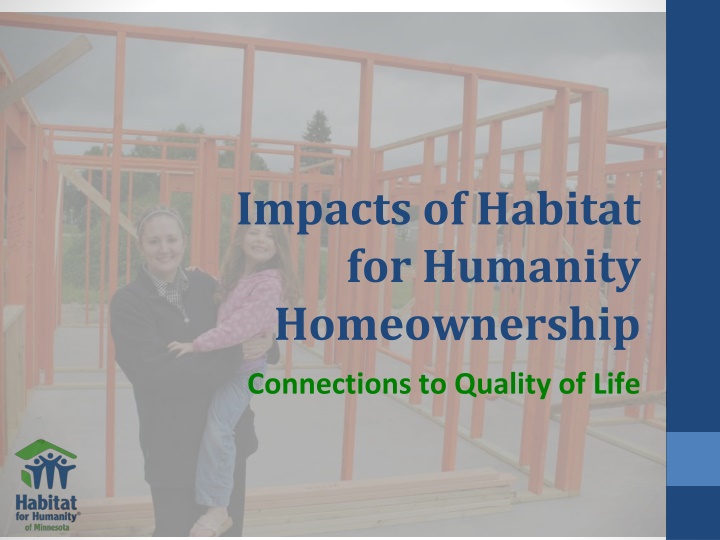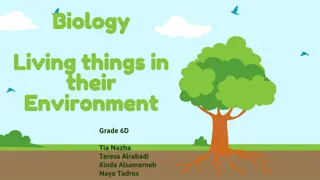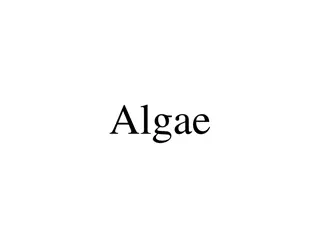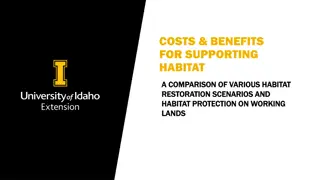Impact of Habitat for Humanity Homeownership on Quality of Life
A study by Wilder Research on Habitat for Humanity homeowners in Minnesota reveals positive impacts on safety, health, education, social connectedness, family interaction, personal well-being, and economic situation. Results show improved quality of life, with high levels of satisfaction and safety reported by homeowners. Significant improvements in respiratory conditions and children's education were also noted, highlighting the positive influence of Habitat homes.
Download Presentation

Please find below an Image/Link to download the presentation.
The content on the website is provided AS IS for your information and personal use only. It may not be sold, licensed, or shared on other websites without obtaining consent from the author.If you encounter any issues during the download, it is possible that the publisher has removed the file from their server.
You are allowed to download the files provided on this website for personal or commercial use, subject to the condition that they are used lawfully. All files are the property of their respective owners.
The content on the website is provided AS IS for your information and personal use only. It may not be sold, licensed, or shared on other websites without obtaining consent from the author.
E N D
Presentation Transcript
Impacts of Habitat for Humanity Homeownership Connections to Quality of Life
About the study Wilder Research conducted phone interviews of 402 homeowners from across Minnesota Investigates connection between Habitat homeownership and quality of life. Safety Health Education Social Connectedness Family Interaction & Personal Well-Being Economic Situation Data analyzed by region (Northern, Southern, Twin Cities) and by length of residence
Homeowner characteristics 55% lived in Habitat home more than 5 years; 87% at least two years 98% have children 70% of respondents were female; in Twin Cities, just 58% vs. 83% in Greater MN
Overall, 92 percent of homeowners said their lives were better Of those 92 percent who said their lives were better, 89 percent said they attributed that positive change either completely or a lot to Habitat. Habitat for Humanity - they make me happy because when you have little children and when they are young, they are jumping or running every day. When you rent, people complain. Now they jump and run and they are free. No one complains. They have a yard, a backyard. We re feeling good, very good.
Homeowners feel safe Over 90% of homeowners feel safe in their homes About 80% feel safer than they were in their previous homes and similar percentage feel that their children are now safer Relatively similar across regions Before we were living in a drug infested neighborhood in a tiny little house that had been made into a duplex. We had lead paint, no furnace filter; there was a hole in the furnace which would leak. I had to tape over the hole so we didn't have to breathe in the fumes. So having this [Habitat] home makes a huge difference of not having to live in that environment.
Homeowners report improvements in respiratory conditions Of homeowners who have a family member with respiratory illnesses, 57 percent said they improved after moving into their Habitat home. Of those with respiratory illnesses, 74 percent of shorter-term homeowners noted an improvement to their condition, whereas 47 percent of longer-term homeowners noted improvement. The improvement with shorter-term homeowners aligns with the implementation of the Healthy Homes program, and more research should be done to explore this connection.
Habitat has positive influence on children s education Over half of homeowners said their children s grades improved after moving into their Habitat home. Impact is more significant for those who were struggling most in previous housing situation. About two-thirds of the homeowners feel more confident about their ability to fund their children s college education. Overall, 90 percent of homeowners said they feel better about their children s future.
Habitat has positive influence on adult education too In 92 percent of the Habitat homes, at least one adult started, completed, or plans to start higher education or training programs after moving in.
Homeowners feel connected More than 80 percent of homeowners reported they feel connected to their community, and over half said they participate more in community activities. Two-thirds of families said their children spend more time with their friends and classmates.
Homeownership affects self-esteem & families Two-thirds of homeowners said they get along better with their families, and 70 percent spend more time with their families. Nearly 90 percent of homeowners said they feel at least somewhat better about themselves, and 75 percent of homeowners feel much better about themselves, compared to before becoming a Habitat homeowner. We get along a lot better. Before we lived in a very cramped place, we fought a lot more - my two sons were not friends at all - now they are best friends. My daughter and I did not have a relationship but since the Habitat house, my daughter and I are very close.
More than 50% have more money and pay less for housing Over half of homeowners said they have more money since moving into their Habitat home, and almost 40 percent said they pay less in housing costs. In nearly half of Habitat households, someone changed jobs since becoming a homeowner. Of those, 80 percent said their jobs are better.
Decreased use of government assistance Overall, 87 percent of homeowners used some form of government assistance at the time of application, and, at the time of the interview, that percentage declined by 20 points. Use of every type of government assistance program except for disability declined by at least 15 percentage points. Cost-benefit analysis - 2,200 Habitat homeowners save Minnesota $6.4 to $9.3 million government assistance programs annually.























